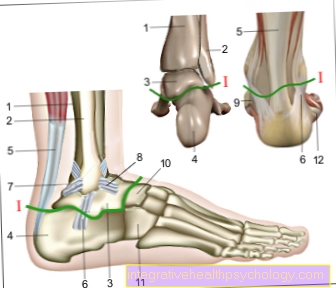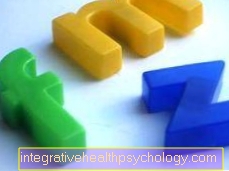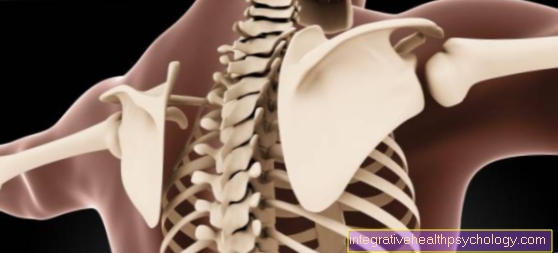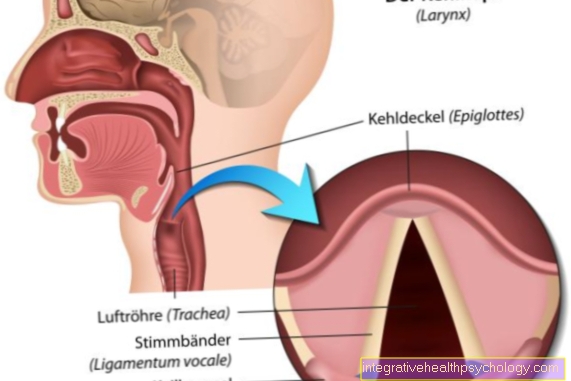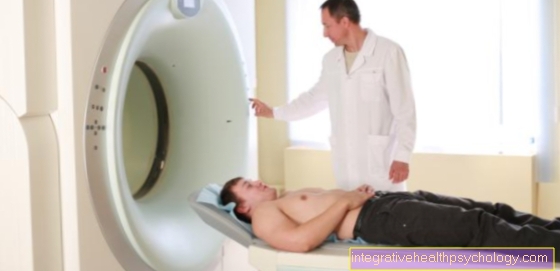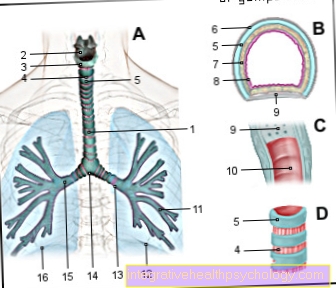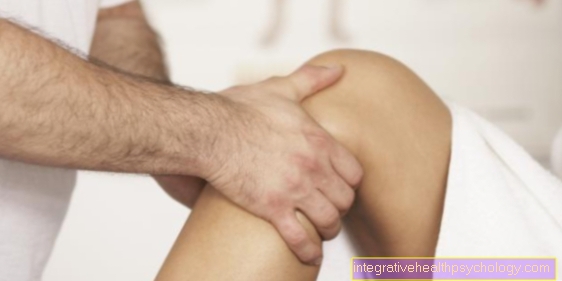Is there a herniated disc without pain?
introduction
The herniated disc is one of the most common neurological diseases in Germany. It is a disease of the peripheral nervous system. In the case of a herniated disc, the intervertebral disc presses on a nerve outlet from the spinal cord.
The resulting symptoms always depend on which part of the outgoing nerve is pressed or touched by the core of the intervertebral disc. The symptoms range from nonexistent symptoms to severe pain, muscle paralysis or paraplegia.

Is there a herniated disc without pain?
A herniated disc without pain is possible and even slightly more common than a herniated disc with pain - at least that's what current studies assume. The bottom line is that a herniated disc that does not cause any symptoms is not examined either, so it is not recognized as a herniated disc.
These are incidental findings that come up during MRI or, more rarely, CT examinations. It is now assumed that around 60% of all herniated discs - as long as one concentrates on the acute event - are accompanied by no symptoms. This means that although the core of the intervertebral disc bulges out or leaves the envelope, the nerve root hardly touches, if at all.
Furthermore, pain is only part of the otherwise typical symptoms of a herniated disc. In addition, there are, for example, symptoms of paralysis in the upper or lower extremities and so-called tingling paresthesia. These are sensory disorders that give a tingling to slightly numb feeling.
In addition, slipped discs can also become noticeable due to muscle weakness. This fact is particularly noticeable when comparing the sides, for example when the left leg can be pulled up against a much higher resistance than the right leg.
However, it is typical of a herniated disc - no matter which symptom occurs - that the symptoms move along a so-called dermatome. These dermatomes are delimited areas of the skin that are supplied by a special nerve from the spinal cord. So that the location of the symptoms also gives the doctor information about where the damage to the nerve will be.
In addition, these symptoms usually only occur unilaterally. Simultaneous symptoms of the same dermatome on both sides of the body do not make one think of a herniated disc until all other possibilities have been ruled out.
Would you like to know more about it? You can read more interesting information here: Signs of a herniated disc
Can it be that the symptoms are not interpreted as a herniated disc?
In very few cases, the patient thinks directly of a herniated disc, but rather of having just lifted up, since herniated discs are often associated with back pain, for which muscular causes could just as well be responsible.
In most cases, those affected assume that if they do not have any signs of paralysis, the pain symptoms will certainly regulate themselves again in some time. Only the simultaneous occurrence of neurological abnormalities (such as tingling paresthesia or symptoms of paralysis) makes most people think of a herniated disc.
In addition, there are a number of differential diagnoses for the herniated disc, some of which produce similar symptoms. For example, peripheral arterial occlusive disease can lead to numbness in the legs or hip arthrosis can produce pain that radiates into the leg.
Appointment with a specialist for a herniated disc?

I would be happy to advise you!
Who am I?
My name is dr. Nicolas Gumpert. I am a specialist in orthopedics and the founder of .
Various television programs and print media report regularly about my work. On HR television you can see me every 6 weeks live on "Hallo Hessen".
But now enough is indicated ;-)
A herniated disc is difficult to treat. On the one hand it is exposed to high mechanical loads, on the other hand it has great mobility.
Therefore, treating a herniated disc requires a lot of experience.
The aim of any treatment is treatment without surgery.
Which therapy achieves the best results in the long term can only be determined after looking at all of the information (Examination, X-ray, ultrasound, MRI, etc.) be assessed.
You can find me in:
- Lumedis - your orthopedic surgeon
Kaiserstrasse 14
60311 Frankfurt am Main
Directly to the online appointment arrangement
Unfortunately, it is currently only possible to make an appointment with private health insurers. I hope for your understanding!
Further information about myself can be found at Dr. Nicolas Gumpert
What can indicate a herniated disc without symptoms?
Real evidence of a herniated disc that does not cause any symptoms in everyday life is almost non-existent; which is why these are usually incidental findings from other examinations. However, there are some neurological provocation tests that may trigger symptoms.For example, bending the entire leg in the supine position ensures that the spinal cord is stretched more and thus possibly presses against the protruding spinal disc nucleus. This could or may not cause pain in the corresponding dermatome.
Furthermore, the occurrence of pain during hard physical work - which mainly affects the back - could be a warning signal. Depending on the position of the spine, it may be that the core of the intervertebral disc is increasingly pressed towards the spinal cord, causing symptoms.
Are you more interested in it? Read our next article on this: How can you recognize a herniated disc?
Just tingling, no pain
As already described, a wide variety of pathways of the body run within a nerve. The doctor speaks of the different fiber qualities of a nerve. It can happen that only a certain fiber quality of a nerve is damaged, but the others are not affected by this damage.
This explains why, for example, there are only disturbed sensations, the so-called tingling paresthesia, but not pain in the affected regions. The tingling sensation can be explained by the fact that fibrous webs that "transport" information from the tactile bodies of the skin have been damaged, so that this particular flow of information is disturbed.
You can read more interesting information on this subject: Tingling sensation in the herniated disc
Just numbness, no pain
Sensory perception and pain are also conducted over two different fiber paths, so that partial failures can also occur here. While the pathways for receiving pain are not damaged, the pathways for depth perception in the corresponding area are.
Disturbances of the fiber tracts can lead to either abnormal sensations or loss of the corresponding nerve quality, as is the case with deafness.
You can read more detailed information on this topic under: Numbness with a herniated disc
Just paralysis, no pain
Muscle activity and pain are also controlled via two different fiber tracts within a nerve. In the case of pain, the direction of the signal flow is from the periphery to the brain, but when muscles are activated it is from the brain towards the periphery, where the corresponding muscle is located.
Here, too, the failure depends on the location and the exact extent of the herniated disc. Which fiber qualities are damaged is more or less a coincidence.
You may also be interested in the next topic: How do I distinguish a herniated disc from a lumbago?
Recommendations from the editorial team
Further general information on this topic:
- Disc herniation pain
- Diagnosing a herniated disc
- MRI for a herniated disc
- Duration of a herniated disc
- Treatment of a herniated disc




